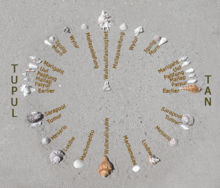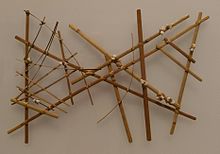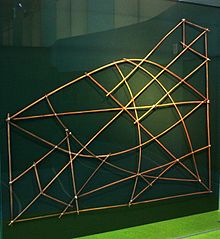
Micronesia is a subregion of Oceania, consisting of about 2,000 small islands in the Northwestern Pacific Ocean. It has a close shared cultural history with three other island regions: Maritime Southeast Asia to the west, Polynesia to the east, and Melanesia to the south—as well as with the wider community of Austronesian peoples.
In Polynesian mythology, Hawaiki is the original home of the Polynesians, before dispersal across Polynesia. It also features as the underworld in many Māori stories.

The Polynesian Voyaging Society (PVS) is a non-profit research and educational corporation based in Honolulu, Hawaiʻi. PVS was established to research and perpetuate traditional Polynesian voyaging methods. Using replicas of traditional double-hulled canoes, PVS undertakes voyages throughout Polynesia navigating without modern instruments.

Hōkūleʻa is a performance-accurate waʻa kaulua, a Polynesian double-hulled voyaging canoe. Launched on 8 March 1975 by the Polynesian Voyaging Society, it is best known for its 1976 Hawaiʻi to Tahiti voyage completed with exclusively traditional navigation techniques. The primary goal of the voyage was to explore the anthropological theory of the Asiatic origin of native Oceanic people as the result of purposeful trips through the Pacific, as opposed to passive drifting on currents or sailing from the Americas. DNA analysis supports this theory. A secondary project goal was to have the canoe and voyage "serve as vehicles for the cultural revitalization of Hawaiians and other Polynesians."
The Micronesians or Micronesian peoples are various closely related ethnic groups native to Micronesia, a region of Oceania in the Pacific Ocean. They are a part of the Austronesian ethnolinguistic group, which has an Urheimat in Taiwan.
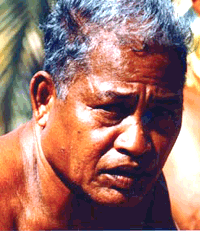
Pius "Mau" Piailug was a Micronesian navigator from the Carolinian island of Satawal, best known as a teacher of traditional, non-instrument wayfinding methods for open-ocean voyaging. Mau's Carolinian navigation system, which relies on navigational clues using the Sun and stars, winds and clouds, seas and swells, and birds and fish, was acquired through rote learning passed down through teachings in the oral tradition. He earned the title of master navigator (palu) by the age of eighteen, around the time the first American missionaries arrived in Satawal. As he neared middle age, Mau grew concerned that the practice of navigation in Satawal would disappear as his people became acculturated to Western values. In the hope that the navigational tradition would be preserved for future generations, Mau shared his knowledge with the Polynesian Voyaging Society (PVS). With Mau's help, PVS used experimental archaeology to recreate and test lost Hawaiian navigational techniques on the Hōkūleʻa, a modern reconstruction of a double-hulled Hawaiian voyaging canoe.
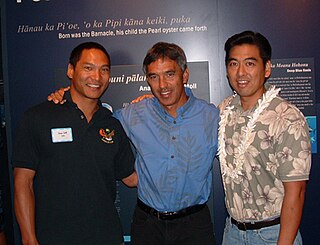
Charles Nainoa Thompson is a Native Hawaiian navigator and the president of the Polynesian Voyaging Society. He is best known as the first Hawaiian to practice the ancient Polynesian art of navigation since the 14th century, having navigated two double-hulled canoes from Hawaiʻi to other island nations in Polynesia without the aid of western instruments.
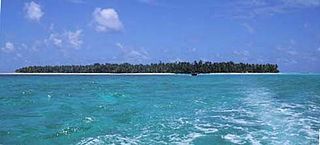
Satawal is a solitary coral atoll of one island with about 500 people on just over 1 km2 located in the Caroline Islands in the Pacific Ocean. It forms a legislative district in Yap State in the Federated States of Micronesia. Satawal is the easternmost island in the Yap island group and is located approximately 70 kilometers (43 mi) east of Lamotrek.

Stick charts were made and used by the Marshallese to navigate the Pacific Ocean by canoe off the coast of the Marshall Islands. The charts represented major ocean swell patterns and the ways the islands disrupted those patterns, typically determined by sensing disruptions in ocean swells by islanders during sea navigation.
David Henry Lewis was a sailor, adventurer, doctor, and scholar of Polynesian culture. He is best known for his studies on the traditional systems of navigation used by the Pacific Islanders. His studies, published in the book We, the Navigators, made these navigational methods known to a wide audience and helped to inspire a revival of traditional voyaging methods in the South Pacific.
Pwo is a sacred initiation ritual, in which students of traditional navigation in the Caroline Islands in Micronesia become navigators (palu) and are initiated in the associated secrets. Many islanders in the area indicate that this ceremony originated on the island of Pollap, or nearby islands.
Alingano Maisu, also known as Maisu, is a double-hulled voyaging canoe built in Kawaihae, Hawaii, by members of Na Kalai Waʻa Moku o Hawaiʻi and ʻOhana Wa'a members from throughout the Pacific and abroad as a gift and tribute to Satawalese navigator Mau Piailug, who navigated the voyaging canoe Hōkūleʻa on her maiden voyage to Tahiti in 1976 and has since trained numerous native Hawaiians in the ancient art of wayfinding. The word maisu comes from the Satawalese word for breadfruit that has been knocked down by storm winds and is therefore available for anyone to take. The name is said to symbolize the knowledge of navigation that is made freely available.

Polynesian navigation or Polynesian wayfinding was used for thousands of years to enable long voyages across thousands of kilometres of the open Pacific Ocean. Polynesians made contact with nearly every island within the vast Polynesian Triangle, using outrigger canoes or double-hulled canoes. The double-hulled canoes were two large hulls, equal in length, and lashed side by side. The space between the paralleled canoes allowed for storage of food, hunting materials, and nets when embarking on long voyages. Polynesian navigators used wayfinding techniques such as the navigation by the stars, and observations of birds, ocean swells, and wind patterns, and relied on a large body of knowledge from oral tradition. This island hopping was a solution to the scarcity of useful resources, such as food, wood, water, and available land, on the small islands in the Pacific Ocean. When an island’s required resources for human survival began to run low, the island's inhabitants used their maritime navigation skills and set sail for new islands. However, as an increasing number of islands in the South Pacific became occupied, and citizenship and national borders became of international importance, this was no longer possible. People thus became trapped on islands with the inability to support them.
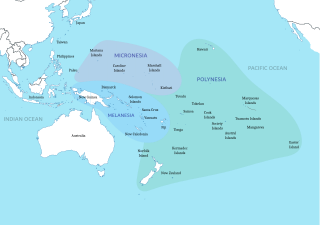
Polynesia is a subregion of Oceania, made up of more than 1,000 islands scattered over the central and southern Pacific Ocean. The indigenous people who inhabit the islands of Polynesia are called Polynesians. They have many things in common, including language relatedness, cultural practices, and traditional beliefs. In centuries past, they had a strong shared tradition of sailing and using stars to navigate at night.
Satawalese is a Micronesian language of the Federated States of Micronesia. It is nearly mutually intelligible with Mortlockese and Carolinian.

Wa are traditional sailing outrigger canoes of the Caroline Islands, Palau, and Yap. They have a single outrigger. They are similar to the sakman of the Northern Marianas.
Hipour was a master navigator from the navigational school of Weriyeng and the island of Puluwat.
We, the Navigators, The Ancient Art of Landfinding in the Pacific is a 1972 book by the British-born New Zealand doctor David Lewis, which explains the principles of Micronesian and Polynesian navigation through his experience of placing his boat under control of several traditional navigators on long ocean voyages.

Sakman, better known in western sources as flying proas, are traditional sailing outrigger boats of the Chamorro people of the Northern Marianas. They are characterized by a single outrigger and a crab claw sail. They are the largest native sailing ships (ladjak) of the Chamorro people. Followed by the slightly smaller lelek and the medium-sized duding. They are similar to other traditional sailing ships of Micronesia, like the wa, baurua, and the walap. These ships were once used for trade and transportation between islands.
etak is a word of Micronesian origin for a distinctive cognitive and mnemonic approach to oceanic navigation and orientation involving a notional reference point or "island", called etak, and triangulation based on it. The system under that name was found in the Caroline Islands, and the literal meaning of etak is "refuge". Alfred Gell described it as a way of encoding dead reckoning applied to sea journeys. It is an example of a dynamic cognitive map.


